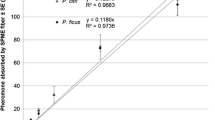Summary
Tests conducted under natural light: dark regimes showed that the release of assembly pheromones by fed males ofAmblyomma hebraeum as well as the response of unfed adult ticks to the pheromones were not affected by daily rhythms.
Similar content being viewed by others
References
W. J. Gladney, R. R. Grabbe, S. E. Ernst and D. D. Oehler, J. med. Ent.11, 303 (1974).
Y. Rechav, G. B. Whitehead and M. M. Knight, Nature259, 563 (1976).
Y. Rechav, H. Parolis, G. B. Whitehead and M. M. Knight, J. med. Ent.14 71 (1977).
C. W. Fatzinger, Annls ent. Soc. Am.66, 1147 (1973).
M. G. Leahy, R. Vanderhey and R. Galun, Nature246, 515 (1973).
A. S. Danilevskii, in: Photoperiodism and seasonal development of insects. Oliver & Boyd, Edinburgh 1965.
M. G. Leahy, in: Perception of 2,6 dichlorophenol in hard Ticks. Conference for Tick-borne diseases and their Vectors, Edinburgh 1976, in press.
Y. S. Chow, C. B. Wang and L. L. Lin, Annls ent. Soc. Am.68, 485 (1975).
Author information
Authors and Affiliations
Rights and permissions
About this article
Cite this article
Rechav, Y. Lack of daily rhythm in the release of assembly pheromones by the tickAmblyomma hebraeum (Koch). Experientia 34, 478–479 (1978). https://doi.org/10.1007/BF01935938
Published:
Issue Date:
DOI: https://doi.org/10.1007/BF01935938




